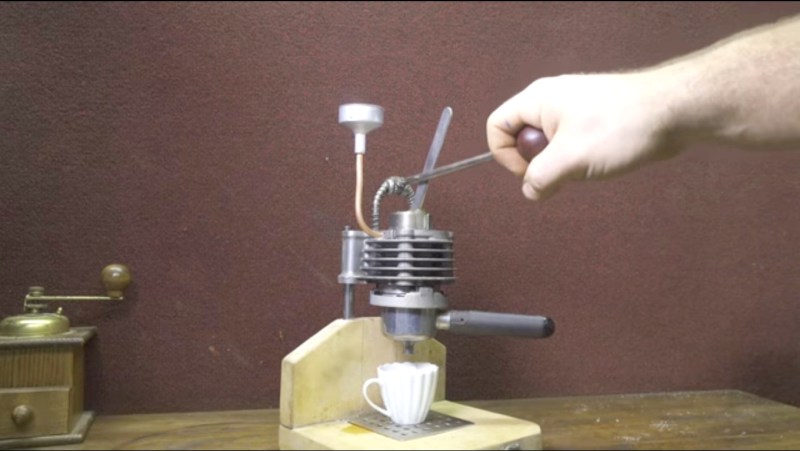[Rulof Maker] is a master at making things from salvaged parts, and being an Italian lover of espresso coffee, this time he’s made an espresso machine. The parts in question are a piston and cylinder from an old motorbike, believe it or not, and parts from an IKEA lamp.
Why the piston and cylinder? For those not familiar with espresso machines, they work by forcing pressurized, almost boiling water through ground coffee. He therefore puts the water in the piston cylinder, and levers the piston down onto it, forcing the water out the bottom of the cylinder and through the waiting coffee grounds. Parts from the IKEA lamp form a base for the waiting cup to sit on.
Of course, he takes great care to clean out any burnt oil and gas before starting. We also like how he centers a lever arm on a U-shaped bolt using two springs. Clever. But see the master in action for yourself in the video below.
For more of [Rulof’s] awesome hacks, check out his leg-mounted beer bottle underwater propulsion system and his surprisingly good sounding microphone made from hard drive parts.
Note: There are two places where the video below is briefly interrupted by a message about the media being offline. Don’t worry, the video continues after them.
















High octane caffeine!
Yummy, nothing like highly acidic coffee run through a steel lined aluminum cylinder….
P.s. Just being facetious…I realize the coffee is in the stainless cup. Looks cool ????
The engine parts are massive and to get good coffee they need to be preheated. Otherwise the coffee will be cold. I feel the difference when my coffee machine is not correctly preheated.
The solution is to make enough espresso that it doesn’t get a chance to cool
Greg is right, good espresso machines preheat the the grouphead, the section where the portafilter is attached. Also this would be better if it was designed similar to a lever espresso machine which drives the piston down via a spring to get the correct brew pressure, 7 to 10 bars.
Still pretty cool machine.
The La Pavoni professional espresso machines are working with the same lever technique. No spring involved. After two weeks of fiddling, you finally get the sense with how much forceto push the lever down. After that lesson, I had the best shots at home.
The fact that the cylinder is designed to shed bunches of heat might be an issue for that. Way more heat than is being used in this application. I don’t know much about making espresso, though, so I consider my opinion to be essentially moot.
Plenty of broken Italian motorbikes, I think they come out of the factory like that.
LOL!
(I own a Piaggio Fly 150)
That’s wonderful- love it
Preheat the cylinder with hot water before you start an s that would eliminate any issues with it cooling the water too much –
I noticed at the end of the video his light bulb coffee machine – that’s worth looking at as well.
Needs a motorcycle grip on the lower handle to complete the look.
Did he retain use of the piston rings?
A coffee for real mens=)